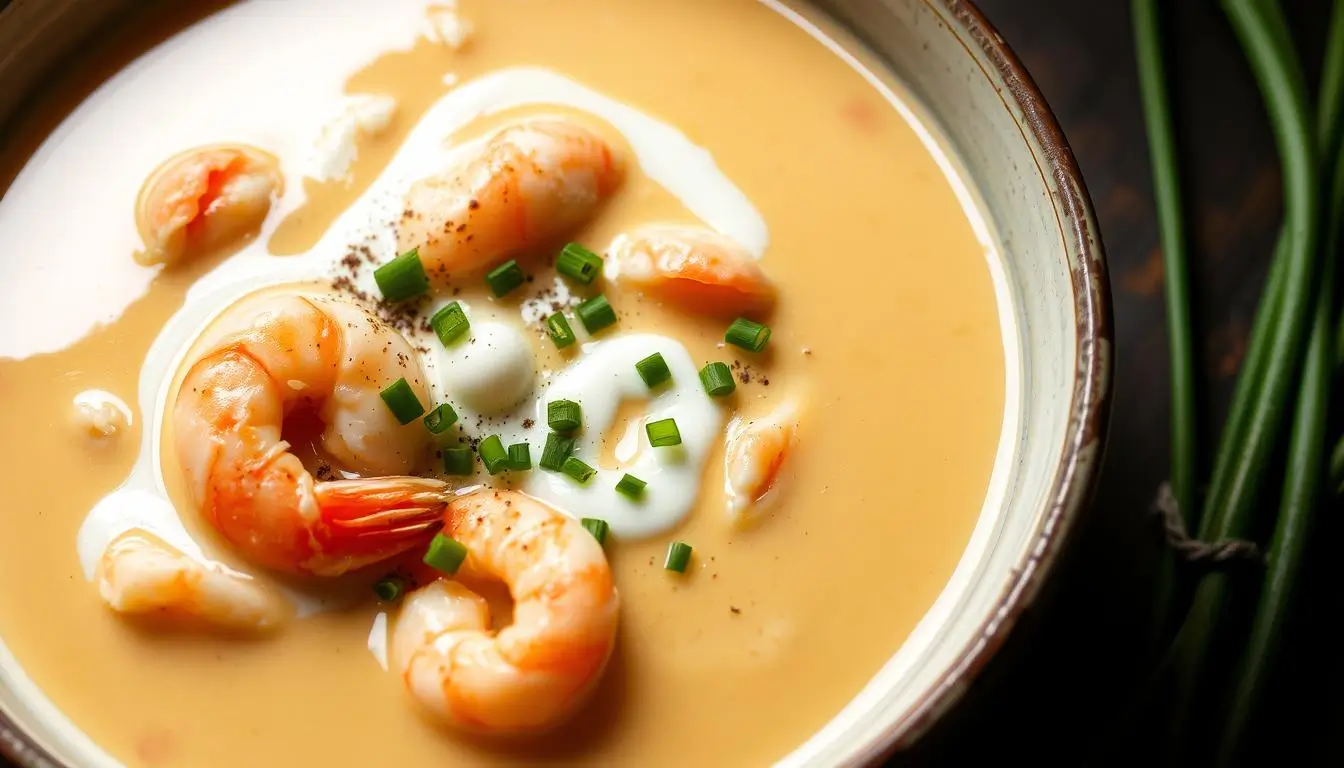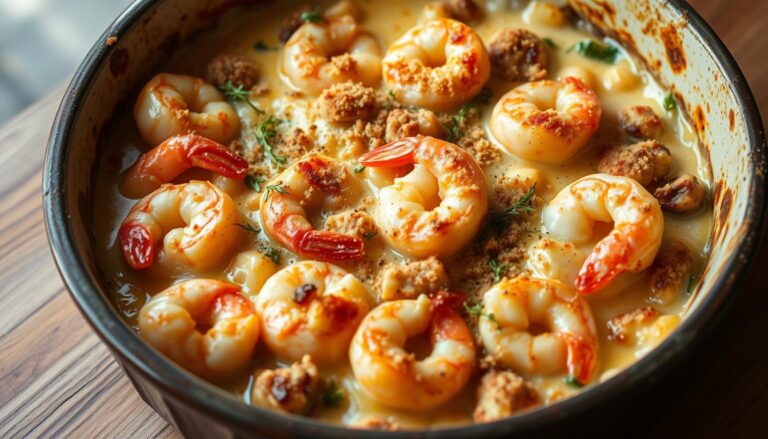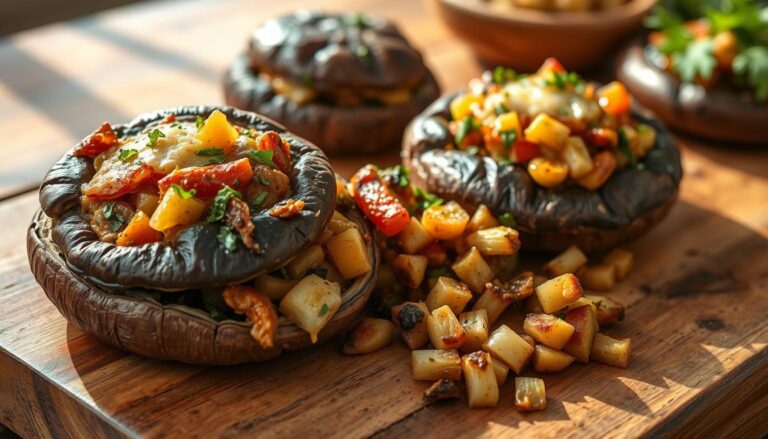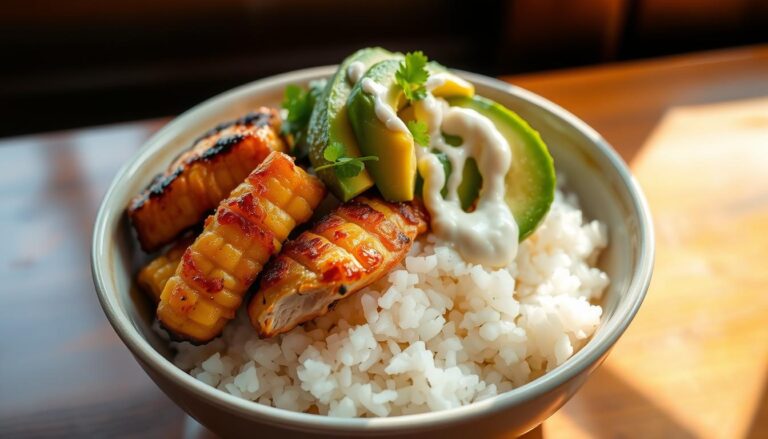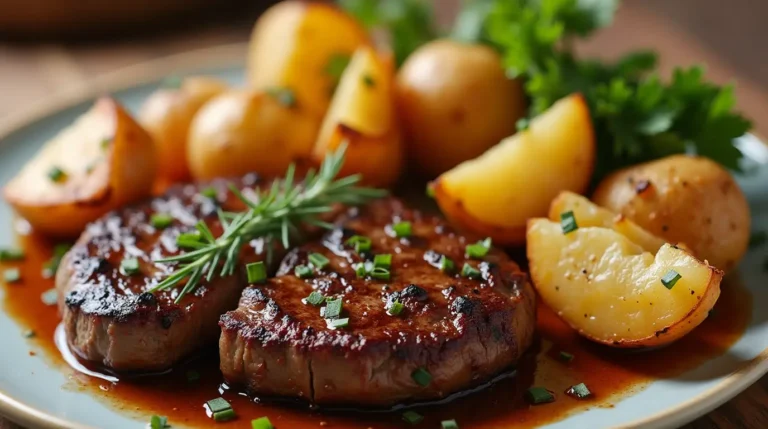Exquisite Seafood Bisque: A Gourmet Comfort in Every Spoonful

Table of Contents
Imagine a cool coastal evening. The smell of seafood bisque fills your kitchen. It’s more than a soup; it’s a journey of flavours.
Your seafood soup is a mix of ocean tastes. It has crab, shrimp, and lobster. The creamy texture feels fancy, and a hint of smokiness from smoked paprika makes it special.
Think about making a fancy seafood bisque in 45 minutes. It’s perfect for big events or cozy dinners at home. A sprinkle of fresh parsley adds a pop of color and flavour.
This dish is not only tasty but also healthy. Each serving has 350-400 calories and 18g of protein. It’s a treat that’s also good for you.
Are you ready to explore gourmet seafood bisque? Let’s discover how to make this amazing dish at home.
Understanding the Rich Heritage of Seafood Bisque
Explore the world of seafood bisque, a journey through time and places. This luxurious soup has a long history, rooted in European cooking traditions. It started in France in the 17th century, made with crayfish or pigeon meat.
Origins of Classic French Bisque
French chefs made bisque a fancy seafood soup. They used crustacean shells to make a rich paste, adding flavor to the broth3. Rice thickened it, and cream made it smooth, defining its elegance.
Evolution into Modern Coastal Cuisine
Seafood bisque changed as it traveled. In New Orleans, it became a Creole favorite, using Gulf seafood like shrimp and blue crab. Artichokes were added by Sicilian immigrants, adding depth to the dish.
Regional Variations Across America
- New England coastal regions developed creamy seafood chowders
- Cajun cuisine created spicier, more rustic interpretations
- Southern coastal areas embraced local seafood variations
Today, seafood bisque is a gourmet comfort food, loved in fancy restaurants and homes. Its history shows how cooking traditions evolve and adapt in different places.
Seafood Bisque Perfection: 8 Professional Kitchen Tools for Creamy, Flavorful Results
| Appliance/Tool | Product | Description |
|---|---|---|
| Immersion Blender | Breville Control Grip | “Achieve velvety-smooth bisque texture in seconds—no transferring to blenders!” |
| Enameled Dutch Oven | Le Creuset 5.5-Qt Round | “Even heat distribution for caramelizing shells into rich, complex broth.” |
| Seafood Scissors | ZWILLING Multi-Purpose | “Effortlessly clean crab legs & lobster shells for freshest flavor extraction.” |
| Digital Scale | OXO Good Grips 11-lb | “Precision-measure seafood & cream for Michelin-worthy consistency.” |
| Fine Mesh Strainer | OXO Double-Wire Strainer | “Silk-like straining for impurities—essential for haute cuisine texture.” |
| Infrared Thermometer | Etekcity Lasergrip 1080 | “Perfect 185°F simmer—prevents curdling cream or overcooked seafood.” |
| Slow Cooker | All-Clad 6-Qt Slow Cooker | “Low-and-slow flavor development like French bistros.” |
| Chilled Soup Bowls | Lenox Portola Double-Wall | “Serve at ideal 140°F—elevates presentation and taste.” |
Essential Ingredients for the Perfect Seafood Bisque
Making a great seafood bisque starts with picking the right ingredients. Whether it’s shrimp, lobster, or crab bisque, the best dish comes from quality parts. Begin your journey to a luxurious seafood bisque with top-notch shellfish and a mix of fragrant ingredients.
The secret to a top seafood bisque is mixing the right ingredients. Here’s what you’ll need:
- Fresh seafood (shrimp, crab, or lobster)
- Unsalted butter for rich flavour
- Aromatic vegetables like green onions and celery
- All-purpose flour for thickening
- Creamy base ingredients: milk and heavy cream
Seasonings are key to making your bisque better. Use tomato paste for depth, black pepper for warmth, and sherry wine for complexity. Add herbs like parsley, cilantro, and green onion tops for a fresh taste.
Pro tip: Don’t be afraid to experiment with different seafood combinations to create your unique bisque masterpiece!
Want to make it your own? Try adding bay scallops or firm fish. The trick to a smooth texture is a flour-based roux.
The Art of Selecting Fresh Seafood Components
Making a great coastal seafood dish starts with picking the best seafood. Your stew’s success depends on the freshness and quality of its ingredients. Knowing how to pick, store, and prepare seafood can make your bisque truly special.
Choosing Quality Shellfish
When picking shellfish for your bisque, focus on a few important things. Crustaceans are full of nutrients that boost your dish’s taste and health. Look for seafood with these key traits:
- Firm shells with a mild ocean scent
- Active movements in live lobsters
- Natural red pigmentation showing it’s freshness
Seasonal Seafood Guide
Seafood is best during certain times of the year. Lobster tails, scallops, and smoked salmon can make your bisque a gourmet treat. Mix in different seafood like shrimp, squid, mussels, and clams for depth and complexity.
“The quality of your seafood determines the soul of your bisque.”
Storage and Preparation Tips
Handling seafood right is key to keeping it fresh. When making your coastal seafood dish, keep these tips in mind:
- Store seafood at the right temperatures
- Pat the seafood dry before cooking
- Choose sustainable seafood sources
Pro tip: Steam lobsters with fresh herbs to boost your bisque’s flavour.
Creating the Perfect Bisque Base
Making a great seafood gumbo or creamy seafood soup starts with a solid base. The base of any top-notch bisque is a rich, flavorful roux. This roux turns simple ingredients into a true culinary gem.
Begin by preparing your base ingredients with care. Your main ingredients will be:
- Butter for a smooth roux
- Chopped shallots and aromatics
- Fresh vegetables like celery and carrots
- Garlic for added flavor
The key to a great creamy seafood soup is a deep, complex flavor. Start by melting butter and slowly adding flour, whisking all the time to avoid lumps. Patience is key – cook your roux until it’s golden, releasing nutty smells that will make your seafood gumbo stand out.
For more depth, try deglazing your pan with dry sherry or cognac11. Add tomato paste for richness, making your base unforgettable.
Pro tip: The quality of your base determines the ultimate success of your bisque.
Nutrition is important too. Your base can be very nutritious, with up to 81.4% protein per serving. By choosing fresh, quality ingredients and mastering the technique, you’ll make a seafood gumbo that’s tasty and healthy.
Mastering the Seafood Bisque Technique
Making the perfect seafood bisque needs skill and attention to detail. To become a bisque expert, learn the key techniques. These steps turn simple ingredients into a rich dish.
The Importance of Proper Roux
A good roux is the base of a great seafood bisque. It affects the dish’s texture and flavor. Here’s how to make it right:
- Use equal parts butter and flour
- Cook slowly to achieve a blonde color
- Stir constantly to prevent burning
Temperature Control Methods
Keeping the right temperature is key when making your bisque. Gentle heat prevents curdling and ensures a smooth consistency. Here’s what pros suggest:
- Heat ingredients gradually
- Avoid high temperatures when adding cream
- Use a thermometer for precision
Achieving Ideal Consistency
The ideal seafood bisque is silky and rich. Getting the right thickness takes patience and skill. Here are some tips:
“A great bisque is about balance – not too thick, not too thin” – Certified Master Chef
- Simmer to reduce and concentrate flavors
- Use an immersion blender for smoothness
- Adjust consistency with stock or cream
Mastering these techniques will help you make a seafood bisque as good as those in restaurants.
Seafood Bisque: A Step-by-Step Recipe Guide
Making a tasty lobster or crab bisque at home is simpler than you might think. This guide will help you make a seafood bisque that will wow your family and friends.

First, let’s look at the key ingredients for a great seafood bisque. You’ll need:
- 1/2 lb fresh pink shrimp, peeled and deveined
- 1/2 lb fresh lump crab meat
- 3 tablespoons unsalted butter
- 1 small onion, diced
- 2 cloves garlic, minced
The secret to a perfect seafood bisque is in how you prepare it. Start by cooking your aromatics until they’re soft and smell great. Then, make a roux by adding flour and cooking for 1-2 minutes. This step is key for deep flavor and a smooth texture.
Here are some pro tips for adding seafood:
- Use fresh seafood for the best taste
- Add seafood in stages to avoid overcooking
- Don’t boil after adding cream to prevent curdling
For more flavor, try these ideas:
- Add a splash of dry white wine
- Sprinkle in Old Bay seasoning
- Garnish with fresh parsley and lemon wedges
Pro tip: Your bisque will taste best when served right away. The seafood’s fresh flavors are at their best immediately after cooking.
Storing leftovers is easy: keep them in the fridge for up to three days and reheat gently. You can also freeze your bisque for up to three months. Enjoy your homemade seafood masterpiece!
Elevating Your Bisque with Wine and Aromatics
Take your rich seafood stew to the next level by mastering wine and aromatics. The right mix can turn your New England seafood soup into a masterpiece that pleases the senses.
Choosing the perfect wine is key to boosting your bisque’s flavor. Dry white wines like Sauvignon Blanc or Pinot Grigio add a crisp touch17. Use about 1¼ cups of wine for a deep, layered taste.
Strategic Wine Pairings
- Sauvignon Blanc: Crisp and acidic
- Chardonnay: Buttery and smooth
- Pinot Grigio: Light and refreshing
Aromatic Herb Combinations
The secret to a great bisque is its aromatics. Classic herbs can make your dish unforgettable. Try these flavor-boosting mixes:
- Thyme and garlic: Earthy and robust
- Tarragon and parsley: Bright and fresh
- Bay leaf and celery: Subtle and complex
Pro tip: Use an immersion blender for a smooth, creamy texture. This blends herbs and wine perfectly17. Your rich seafood stew will be a memorable dish that highlights coastal cuisine.
Garnishing and Presentation Techniques
To make your creamy seafood soup look amazing, focus on garnishing. The right presentation can turn a simple dish into a work of art18. Fresh herbs add color and flavor, making your soup stand out.
- Sprinkle chopped fresh parsley and green onion tops for vibrant color
- Add a delicate drizzle of cream in an artistic swirl
- Garnish with citrus zest to introduce a bright, acidic note
- Use microgreens for texture and fresh finish
Experts say to use garnishes wisely, so they don’t overpower the soup. Try unique garnishes like edible flowers or spice blends for a wow factor.
| Garnish Type | Visual Impact | Flavor Enhancement |
|---|---|---|
| Fresh Herbs | High | Moderate |
| Citrus Zest | Medium | High |
| Microgreens | Medium | Low |
The aim is to make your soup look good and taste great. With these tips, you’ll wow your guests and show off your cooking skills.
Complementary Side Dishes and Pairings
To make your seafood bisque special, think about what goes with it. The right sides and drinks can make your meal unforgettable.

Bread Selection: The Perfect Companion
Finding the perfect bread can make your seafood chowder or gumbo better. Here are some great choices:
- Classic French Baguette: Its crisp crust and soft inside are perfect for dipping
- Rustic Sourdough: Its tangy taste goes well with the rich bisque
- Herb-Infused Focaccia: The herbs add a nice contrast to the creamy bisque
Salad Selections to Balance Your Bisque
A light salad can balance out the richness of your seafood bisque:
- Mixed Greens Salad: Try it with arugula and spinach and a lemon vinaigrette
- Citrus Salad: Oranges and grapefruit add a nice touch
- Greek Salad: It’s got crisp cucumber and tangy feta
Wine and Beverage Pairings
The right drink can take your seafood bisque to the next level:
- Champagne: It adds a touch of luxury to your meal
- Chardonnay: A classic choice for creamy seafood dishes
- Light, crisp white wines that match the bisque’s richness
“A perfectly paired beverage can transform a good meal into an unforgettable culinary journey.”
Remember, pick pairings that bring out the best in your seafood bisque. Choose sides and drinks that complement its flavors without overpowering them.
Troubleshooting Common Bisque Challenges
Making the perfect seafood bisque can be tricky, even for experienced cooks. Knowing the common pitfalls helps you master this dish. It also helps you avoid mistakes that can ruin your shrimp bisque.
Several challenges can arise when making seafood bisque. These might affect the final taste and texture. Let’s look at some key issues and how to solve them:
- Cream Curdling: Prevent separation by adding cream slowly and keeping the temperature low
- Inconsistent Texture: Adjust thickness by watching your roux and liquid ratios
- Seafood Texture Problems: Avoid overcooking to prevent rubbery shrimp or tough seafood
Flavor is key for a great seafood bisque. Consider these quick fixes:
- Add spices like cayenne or smoked paprika to boost taste
- Incorporate shallots and garlic for depth
- Use sherry to introduce complexity
“The secret to a great bisque is patience and careful technique”
Watch for these signs that might mean you’re doing something wrong in your shrimp bisque:
| Problem | Potential Cause | Solution |
|---|---|---|
| Fishy Smell | Seafood Quality | Use fresh ingredients, rinse thoroughly |
| Bland Flavor | Insufficient Seasoning | Layer herbs, spices, and aromatics |
| Grainy Texture | Improper Roux | Stir constantly, cook at medium-low heat23 |
By knowing these common seafood bisque challenges, you can make a dish that rivals restaurants. You can do it all in your own kitchen.
Storage and Reheating Guidelines
Keeping your lobster bisque or crab bisque fresh is key. You need to store and reheat it correctly. This way, you can enjoy its rich, creamy taste without losing it.
Here are the must-know tips for storing your seafood bisque:
- Refrigerate your bisque in an airtight container
- Store for up to 3-4 days in the fridge
- Cool it fast by putting the container in an ice bath
Freezing your bisque can make it last longer, but you must be careful. Pro tip: Don’t add cream before freezing to avoid it separating26. You can freeze seafood bisque for 2-3 months in an airtight container.
Reheating needs to be done gently to keep the bisque smooth:
- Defrost it in the fridge overnight
- Warm it up slowly on the stovetop
- Stir it now and then to stop it from burning
- Don’t boil it to keep the texture right
If you follow these steps, your seafood bisque will taste as good as when you first made it.
Conclusion
Your journey into the world of coastal seafood delicacies has been exciting. You’ve learned to make a rich seafood stew that’s more than just a recipe. It’s a way to connect with centuries of food traditions.




You’ve discovered how to get a creamy texture and balance flavors. This has unlocked the secrets of a truly special dish.
This guide showed you how versatile seafood bisque can be. It’s perfect for a quick dinner or a fancy party. You can make it your own by changing ingredients and trying different shellfish.
Cooking is about passion, creativity, and showing who you are. Your seafood bisque shows off your cooking skills and knowledge. Don’t be shy to try new things and make it your own.
Keep exploring and enjoying your culinary adventures. Your seafood bisque is a chance to share joy with others. Enjoy every moment of cooking and tasting.
FAQ
What is the difference between a bisque and a chowder?
Can I make seafood bisque with frozen seafood?
How long can I store homemade seafood bisque?
What’s the best way to prevent my bisque from curdling?
Can I make a vegetarian version of seafood bisque?
What wines pair best with seafood bisque?
How can I make my bisque more spicy?
Is seafood bisque healthy?
Can I use canned seafood in my bisque?
What are some unique garnish ideas for seafood bisque?
How did you find this recipe?
There are no reviews yet. Be the first one to write one.

